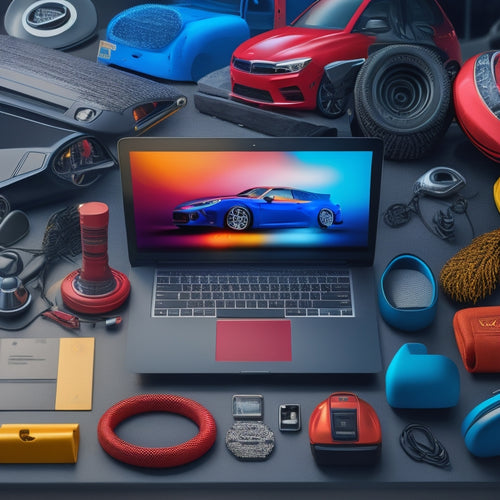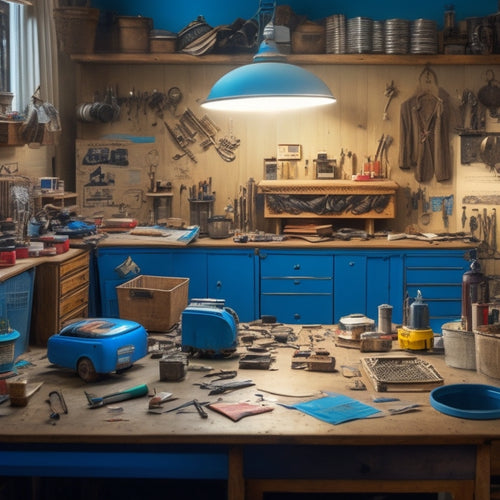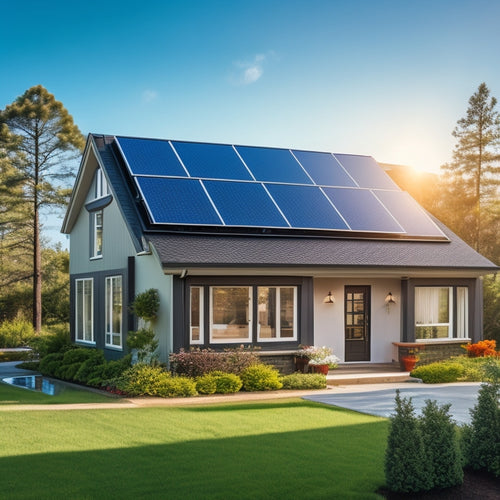
7-Step Guide to Installing Solar Power for Your Off-Grid Cabin
Share
You're about to utilize the power of the sun for your off-grid cabin, and with these 7 essential steps, you'll design and install a reliable solar power system that meets your energy needs. Start by evaluating your energy requirements, then choose the right equipment, considering factors like efficiency, durability, and cost. Next, design your solar array, considering orientation, layout, and tilt to maximize sunlight capture. Prepare the installation site, ensuring accessibility and conducting environmental and shading analyses. Install the solar panels, set up the battery bank, and connect the inverter system. Finally, test and maintain your system, monitoring performance and making adjustments as needed. Get ready to unleash the full potential of your off-grid solar power system.
Key Takeaways
- Assess energy needs by calculating total daily watt-hour requirement to determine the right solar panel array and battery bank size.
- Choose solar panels based on efficiency, durability, and cost, and consider factors like maintenance requirements and aesthetics.
- Design a scalable system with monitoring and power management features, and consider backup options like generators or energy storage systems.
- Select the right battery type based on storage capacity, maintenance requirements, and cost, and consider eco-friendly choices and safety features.
- Ensure proper installation by preparing the site, configuring the array, and setting up the battery bank and inverter system correctly.
Assessing Your Energy Needs
Before diving into the installation of solar power for your off-grid cabin, it's essential to evaluate your energy needs. This step is often overlooked, but it's important to guarantee you have a system that meets your power requirements.
To do this, you'll need to calculate your energy consumption. Start by identifying the appliances and devices you'll be powering, including lights, refrigerators, and computers.
Next, determine the wattage of each item and the number of hours it'll be used daily. This will give you a total daily watt-hour requirement.
Consider your power efficiency goals, too. Are you looking to reduce your energy consumption or maintain your current usage? Knowing this will help you determine the size of your solar panel array and battery bank.
Accurately evaluating your energy needs will provide a reliable and efficient solar power system that meets your off-grid cabin's unique demands. By doing so, you'll avoid overspending on unnecessary equipment and guarantee a smooth shift to off-grid living.
Choosing the Right Equipment
You'll need to select solar panels that meet your energy requirements, considering factors like efficiency, durability, and cost.
Next, you'll need to size your system correctly, factoring in your energy needs, available sunlight, and battery capacity.
Solar Panel Selection
Selecting the right solar panels for your off-grid cabin is an essential decision, as it directly impacts the system's overall performance and your ability to meet your energy needs. You'll want to evaluate factors like solar panel types, efficiency ratings, and panel warranties.
| Solar Panel Type | Key Features |
|---|---|
| Monocrystalline | High efficiency (20-22%), durable, and expensive |
| Polycrystalline | Mid-range efficiency (15-18%), affordable, and popular |
| Thin-Film | Low efficiency (7-14%), flexible, and budget-friendly |
| Bifacial | High efficiency (20-22%), captures light from both sides, and premium |
| PERC | High efficiency (20-22%), affordable, and widely available |
When comparing brands, look at installation costs, environmental impact, and aesthetic options. Some brands offer sleek, black panels that blend in with your cabin's roof, while others provide more affordable options with a bluer tint. Maintenance requirements also vary, with some panels featuring built-in cleaning systems. By evaluating these factors, you'll find the perfect solar panels for your off-grid cabin.
System Sizing Considerations
Every watt counts when it comes to powering your off-grid cabin, and sizing your solar power system correctly is vital to meeting your energy needs. To get it right, you'll need to perform load calculations to determine your cabin's energy requirements. This involves accounting for the wattage of each appliance, lighting fixture, and other devices, as well as their usage patterns.
Seasonal adjustments are also important, as your energy needs may vary depending on the time of year. For maximum energy efficiency, consider incorporating system monitoring and power management features into your setup. These will help you track your energy production and consumption, identify areas for improvement, and optimize your system's performance.
Additionally, think about backup options, such as generators or energy storage systems, to guarantee you have a reliable source of power during periods of low sunlight or high energy demand. If you're planning for future expansion, consider how your system will interact with the grid, if at all, and design it with scalability in mind.
Battery Type Options
As you've sized your solar power system to meet your off-grid cabin's energy needs, it's time to focus on the equipment that will store the generated energy: batteries.
When choosing the right battery type, you'll need to take into account factors such as storage capacity, maintenance requirements, and cost considerations. Lithium options offer higher efficiency ratings and faster discharge rates, making them ideal for off-grid systems. However, they come at a higher upfront cost.
Lead acid alternatives, on the other hand, are more affordable but require more maintenance and have lower efficiency ratings.
Battery longevity is also an important factor, as it directly affects the overall lifespan of your solar power system. Look for batteries with a long warranty period and a proven track record of performance.
Additionally, think about eco-friendly choices that minimize environmental impact. Safety features, such as built-in protection against overcharging and overheating, are also essential.
Designing Your Solar Array
You'll need to select the right solar panels for your off-grid cabin, factoring in elements like efficiency, durability, and cost.
Next, you'll configure your array to optimize energy production, choosing from options like series and parallel connections, and adjusting tilt and orientation to match your cabin's location.
Solar Panel Selection
Selecting the right solar panels for your off-grid cabin is essential to secure a reliable and efficient energy supply. You'll want to take into account panel efficiency, which affects how much energy you can generate per hour of sunlight. Higher efficiency panels may cost more, but they can be a good investment if you have limited space.
When evaluating panels, look for their wattage, voltage, and ampere ratings. Verify they're compatible with your system's requirements. You should also take into account the panel's durability, warranty, and certifications.
Installation costs are another important factor. While high-efficiency panels may be more expensive upfront, they can reduce your overall installation costs by requiring fewer panels to achieve the same energy output.
Additionally, factor in the cost of mounting hardware, wiring, and inverters when calculating your total installation costs.
Array Configuration Options
With your solar panels chosen, it's time to configure them into a solar array that maximizes energy production for your off-grid cabin. This involves deciding on the array's orientation, layout, and tilt to capture the most sunlight possible.
When designing your solar array, consider the following array configuration options:
-
Array orientation strategies: Determine the best direction for your array to face, taking into consideration shading from trees or other obstacles. In the northern hemisphere, a south-facing array is usually ideal.
-
Ideal tilt: Adjust the tilt of your array to match your latitude, ensuring the panels are perpendicular to the sun's rays during peak hours. A steeper tilt can be beneficial in areas with heavy snowfall.
-
Panel spacing and layout: Leave enough space between panels to allow for air circulation and reduce shading from adjacent panels.
- Ground or roof mounting: Choose between ground-mounted or roof-mounted arrays, considering factors like available space, structural integrity, and local building codes.
Energy Output Calculations
Across the globe, solar panels are optimized to capture maximum energy from the sun, and your off-grid cabin is no exception. To guarantee you're getting the most out of your solar array, you need to calculate the energy output. This involves evaluating your cabin's solar exposure, energy efficiency, and overall energy requirements.
You'll need to determine the peak sun hours your cabin receives daily. Peak sun hours are the hours when the sun's energy is strongest, usually between 9 am and 3 pm. This will help you calculate the total daily energy output of your solar array.
Consider factors like shading, panel angle, and orientation to maximize energy production.
Next, calculate your cabin's energy efficiency by considering the appliances and devices you'll be powering. This will help you determine the total energy required to power your off-grid cabin.
Preparing the Installation Site
Your off-grid cabin's remote location demands careful planning and preparation to secure a successful solar power installation. Before installing your solar power system, it's vital to prepare the installation site to guarantee a smooth and efficient process.
To prepare the site, consider the following key factors:
-
Site accessibility: Verify the installation site is easily accessible for your team and equipment. Clear any debris, trees, or obstacles that may hinder the installation process.
-
Environmental impact: Assess the environmental impact of the installation on the surrounding ecosystem. Avoid areas with sensitive habitats or protected species.
-
Shading analysis: Conduct a shading analysis to identify potential shading sources, such as trees or buildings, that may affect the system's performance.
- Ground stability: Evaluate the ground stability to verify it can support the weight of the solar panels and mounting structure.
Installing the Solar Panels
The solar panels are now ready to be installed, marking an essential step in bringing your off-grid cabin's solar power system to life. You've prepared the site, and now it's time to secure the panels in place.
Choose a mounting technique that suits your cabin's roof type, whether it's a flush mount, tilt mount, or tracking system. Confirm the mounting hardware is compatible with your panel frames and can withstand local weather conditions.
Next, determine the ideal panel orientation. In the northern hemisphere, a south-facing orientation is ideal, but you may need to adjust for obstructions or shading. Consider a dual-axis tracking system if you have limited roof space or want to maximize energy output.
Make certain to follow the manufacturer's installation guidelines and local building codes. Secure the panels firmly, confirming a watertight seal to protect them from the elements.
Setting Up the Battery Bank
With your solar panels installed, it's now time to set up the battery bank, a critical component of your off-grid cabin's solar power system.
When setting up your battery bank, consider the following key factors:
-
Battery Placement: Confirm your batteries are placed in a well-ventilated area, away from direct sunlight and heat sources, to prolong their lifespan.
-
Wiring Configuration: Design a wiring configuration that minimizes voltage drop and reduces the risk of electrical shock. Use heavy-gauge wires and follow industry-standard color-coding practices.
-
Battery Type and Capacity: Select deep-cycle batteries specifically designed for off-grid solar systems. Calculate your battery capacity based on your energy needs, considering factors like days of autonomy and depth of discharge.
- Monitoring and Maintenance: Install a battery monitoring system to track your battery's state of charge, voltage, and temperature. Regularly inspect and maintain your batteries to guarantee peak performance.
Connecting the Inverter System
Reliability hinges on the seamless integration of the inverter system, which converts DC power from your battery bank into AC power for your off-grid cabin's appliances. When connecting the inverter system, you'll need to take into account inverter placement and wiring considerations.
Place the inverter in a well-ventilated area, away from direct sunlight and moisture, to guarantee peak performance and longevity. Typically, the inverter is installed near the battery bank to minimize DC wiring runs and reduce energy losses. Confirm the inverter is mounted securely to a wall or shelf, following the manufacturer's instructions.
Wiring considerations are essential to guarantee safe and efficient energy transmission. Use the recommended wire sizes and types to connect the inverter to the battery bank and the AC distribution panel.
Keep DC wiring runs as short as possible, and use proper connectors and fuses to prevent electrical shock and fire hazards. Follow the inverter manufacturer's guidelines for wiring and installation to assure a safe and reliable connection.
Testing and Maintenance Tips
One essential step remains before you can fully enjoy your off-grid cabin's solar power system: testing and maintaining it. This guarantees your system operates efficiently and safely throughout the year.
To keep your system in top condition, follow these routine checks and maintenance tasks:
-
Performance Monitoring: Regularly review your system's performance data to identify any issues or areas for improvement.
-
Seasonal Adjustments: Adjust your system's angle and orientation to optimize energy production during different seasons.
-
Cleaning Methods: Clean your solar panels regularly to guarantee maximum energy absorption. Use a soft brush and mild soap to avoid damaging the panels.
- Troubleshooting Techniques: Familiarize yourself with common issues and their solutions to quickly address any problems that arise.
Additionally, prioritize safety precautions, such as wearing protective gear when working with electrical systems, and consider system upgrades to improve efficiency.
Frequently Asked Questions
Can I Install Solar Power Myself or Do I Need a Professional?
You can attempt a DIY solar installation, but it's essential to reflect on your technical knowledge and time commitment, as solar system components require precise configuration to guarantee ideal performance and safety.
How Long Does a Solar Power System Typically Last?
As you bask in the warmth of your off-grid cabin, you wonder about the longevity of your solar power system. Typically, it'll last 25-30 years, with a solar panel lifespan of 30-40 years, requiring minimal maintenance to guarantee peak performance.
Will Solar Power Work During a Power Outage?
You'll be glad to know that, yes, solar power works during a power outage, thanks to a battery backup system, ensuring energy independence and maintaining solar efficiency, even when the grid goes down.
Are There Any Government Incentives for Off-Grid Solar Installations?
You're eligible for government incentives like tax credits, which can greatly offset your off-grid solar installation costs, as the US promotes renewable energy adoption - making your eco-friendly choice even more attractive and cost-effective.
Can I Expand My Solar Power System in the Future if Needed?
You're not stuck with a one-size-fits-all solar system; you can upgrade your system's capacity like a boss, effortlessly adding more panels or inverters as your energy needs skyrocket, thanks to smart capacity planning and flexible system upgrades.
Conclusion
Congratulations, you've made it! You've survived the chaos of wires, panels, and batteries. And, irony of ironies, you're now ready to plug into the simplicity of off-grid living. Your solar power system is up and running, silently generating energy while you're out enjoying the peace and quiet. Now, go ahead and turn on that light, charge that laptop, and revel in the sweet feeling of independence from the grid.
Related Posts
-

Top 10 Tips for Buying Car Accessories Online
When purchasing car accessories online, you should take proactive steps to avoid low-quality or incompatible products...
-

Top 10 DIY Conversion Kit Reviews and Tips
You're taking the first step towards electrifying your ride, and with the right DIY conversion kit, you'll be cruisin...
-

Solar Power Units Perfect for Homes
You're considering installing a solar power unit in your home, a decision that can notably reduce your reliance on tr...


